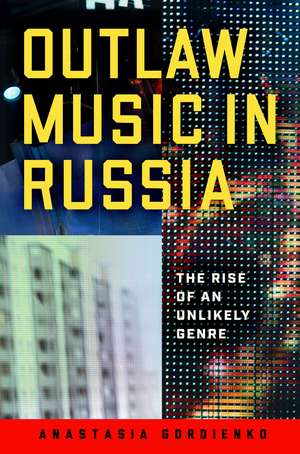Outlaw Music in Russia: The Rise of an Unlikely Genre
Autor Anastasia Gordienkoen Limba Engleză Hardback – 24 ian 2023
With careful research and incisive analysis, Gordienko deftly details the shanson’s history, development, and social meanings. Attempts by imperial rulers, and later by Soviet leaders, to repress the songs and the lifestyles they romanticized not only did little to discourage their popularity but occasionally helped the genre flourish. Criminals and liberal intelligentsia mingled in the Gulag system, for instance, and this contact introduced censored songs to an educated, disaffected populace that inscribed its own interpretations and became a major point of wider dissemination after the Gulag camps were closed. Gordienko also investigates the shanson as it exists in popular culture today: not divorced from its criminal undertones (or overtones) but celebrated for them. She argues that the shanson expresses fundamental themes of Russian culture, allowing for the articulation of anxieties, hopes, and dissatisfactions that are discouraged or explicitly forbidden otherwise.
Preț: 526.55 lei
Preț vechi: 683.83 lei
-23% Nou
Puncte Express: 790
Preț estimativ în valută:
100.82€ • 104.98$ • 83.65£
100.82€ • 104.98$ • 83.65£
Carte tipărită la comandă
Livrare economică 14-28 februarie
Preluare comenzi: 021 569.72.76
Specificații
ISBN-13: 9780299340100
ISBN-10: 0299340104
Pagini: 336
Dimensiuni: 152 x 229 x 25 mm
Greutate: 0.63 kg
Ediția:First Edition
Editura: University of Wisconsin Press
Colecția University of Wisconsin Press
ISBN-10: 0299340104
Pagini: 336
Dimensiuni: 152 x 229 x 25 mm
Greutate: 0.63 kg
Ediția:First Edition
Editura: University of Wisconsin Press
Colecția University of Wisconsin Press
Recenzii
“A clear and entertaining overview of a vital, integral part of post-Soviet Russian culture—a joy to read.”—Eliot Borenstein, New York University
“This fascinating book, both deeply researched and highly entertaining, provides valuable insights into Russian cultural history and should be required reading for all interested in the history of Russian popular song.”—Karen Evans-Romaine, University of Wisconsin–Madison
“A rigorous examination. . . . [Gordienko] unearths many intriguing aspects of the shanson. Russophiles and musicologists will savor this impressive study.”—Publishers Weekly
“A seminal work of simply outstanding scholarship. . . . Unique and highly recommended.”—Midwest Book Review
“[Gordienko] is among the first to conduct in-depth research on [shanson]. The result is this detailed, extensively documented study.”—CHOICE
“Vivid and engrossing. . . . The sophistication of [Gordienko’s] methodology—which is as likely to refer to Adorno and Habermas as it is to historians and sociologists of Russia—is lightly worn and informed by some fifteen years of close-up anthropological observation working in the world of Russian and Ukrainian broadcasting.”—Slavonic and East European Review
“This fascinating book, both deeply researched and highly entertaining, provides valuable insights into Russian cultural history and should be required reading for all interested in the history of Russian popular song.”—Karen Evans-Romaine, University of Wisconsin–Madison
“A rigorous examination. . . . [Gordienko] unearths many intriguing aspects of the shanson. Russophiles and musicologists will savor this impressive study.”—Publishers Weekly
“A seminal work of simply outstanding scholarship. . . . Unique and highly recommended.”—Midwest Book Review
“[Gordienko] is among the first to conduct in-depth research on [shanson]. The result is this detailed, extensively documented study.”—CHOICE
“Vivid and engrossing. . . . The sophistication of [Gordienko’s] methodology—which is as likely to refer to Adorno and Habermas as it is to historians and sociologists of Russia—is lightly worn and informed by some fifteen years of close-up anthropological observation working in the world of Russian and Ukrainian broadcasting.”—Slavonic and East European Review
“Wonderful and thoroughly engaging. . . . Breaks new grounds.”
“Gordienko makes a valuable and convincing argument for the tangible effects that popular music can have on politics and culture, rather than music only serving as a reflection of society for scholarly observation. It will surely be a foundational work.”
Notă biografică
Anastasia Gordienko is an assistant professor of Russian and Slavic studies at the University of Arizona.
Cuprins
Contents
List of Illustrations
Acknowledgments
A Note on Translation and Transliteration
Introduction
1 Contextualizing the Shanson Phenomenon
2 Criminals’ Music from Its Origins to the Early Soviet Period: A Glorified Archetype
3 Soviet Underworld Music: From the Bolshevik Revolution through the End of the Stalin Era
(1917–1950s)
4 From Post-Stalinist Censorship to the Contemporary Mainstream: The Birth of the Shanson
5 The Shanson: Main Features and Tropes
6 The Shanson in Russia: From the Slums to the Kremlin
7 Turning Russia’s Immediate Reality into Song
Epilogue: The Shanson—Soundtrack to Russian Reality
Glossary
Notes
Bibliography
Index
List of Illustrations
Acknowledgments
A Note on Translation and Transliteration
Introduction
1 Contextualizing the Shanson Phenomenon
2 Criminals’ Music from Its Origins to the Early Soviet Period: A Glorified Archetype
3 Soviet Underworld Music: From the Bolshevik Revolution through the End of the Stalin Era
(1917–1950s)
4 From Post-Stalinist Censorship to the Contemporary Mainstream: The Birth of the Shanson
5 The Shanson: Main Features and Tropes
6 The Shanson in Russia: From the Slums to the Kremlin
7 Turning Russia’s Immediate Reality into Song
Epilogue: The Shanson—Soundtrack to Russian Reality
Glossary
Notes
Bibliography
Index
